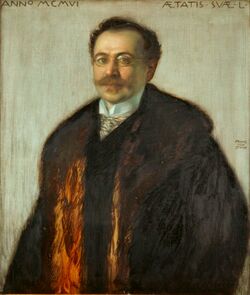Biography:Leo Graetz
From HandWiki
Short description: German physicist
Leo Graetz | |
|---|---|
 Leo Graetz, painted by Franz von Stuck (1906) | |
| Born | Breslau, Prussia |
| Died | 12 November 1941 (aged 85) |
| Known for | Graetz number, Diode bridge |
Leo Graetz (26 September 1856 – 12 November 1941) was a German physicist. He was born in Breslau, Germany, and was the son of historian Heinrich Graetz.
Graetz was one of the first to investigate the propagation of electromagnetic energy. The Graetz number (Gz), a dimensionless number describing heat flow, is named after him.[1] Also sometimes known by his name is the diode bridge rectifier circuit that was invented by Polish electrotechnician Karol Pollak in 1896[2] and that was independently invented and published by Leo Graetz in 1897.[3]
In 1880 he confirmed the Stefan–Boltzmann law.[4]
Graetz died in Munich at age 85.
Publications
- Die Elektrizität und ihre Anwendungen (Electricity and Its Applications), Stuttgart 1903 Digital 17th edition from 1914 by the University and State Library Düsseldorf
- Handbuch der Elektrizität und des Magnetismus (Handbook of Electricity and Magnetism) - 5 volumes, 1918, 1921, 1923, 1920, 1928
- Recent developments in atomic theory, 1922
References
- ↑ See:
- Graetz, L. (1883). "Über die Wärmeleitungsfähigkeit von Flüssigkeiten" (in German). Annalen der Physik und Chemie. 3rd series 18 (1): 79–94. https://babel.hathitrust.org/cgi/pt?id=wu.89048352520;view=1up;seq=95.
- Graetz, L. (1885). "Über die Wärmeleitungsfähigkeit von Flüssigkeiten [Part 2"] (in German). Annalen der Physik und Chemie. 3rd series 25 (7): 337–357. https://babel.hathitrust.org/cgi/pt?id=wu.89048352553;view=1up;seq=359.
- ↑ That Karol ("Charles") Pollak had invented a diode bridge prior to Leo Graetz is mentioned in:
- (Graetz, 1897), p. 327 footnote.
- (Editorial staff) (24 June 1897). "Ein neues Gleichrichter-Verfahren" (in German). Elektrotechnische Zeitschrift 18 (25): 359 and footnote. https://babel.hathitrust.org/cgi/pt?id=njp.32101050985074;view=1up;seq=381.
- ↑ See:
- Graetz, L. (1 May 1897). "Electrochemisches Verfahren, um Wechselströme in Gleichströme zu verwandeln" (in German). Sitzungsberichte der Mathematisch-Physikalischen Classe der Königlich Bayerischen Akademie der Wissenschaften zu München (Transactions of the Mathematical-Physical Classes of the Royal Bavarian Academy of Sciences in Munich) 27 (10): 223–228. doi:10.1002/andp.18972981008. Bibcode: 1897AnP...298..323G. https://babel.hathitrust.org/cgi/pt?id=hvd.32044092897610;view=1up;seq=1069.
- Graetz, L. (1897). "Electrochemisches Verfahren, um Wechselströme in Gleichströme zu verwandeln" (in German). Annalen der Physik und Chemie. 3rd series 62 (10): 323–327. doi:10.1002/andp.18972981008. Bibcode: 1897AnP...298..323G. https://zenodo.org/record/1604539/files/article.pdf.
- Graetz, Leo (22 July 1897). "Electrochemisches Verfahren, um Wechselströme in Gleichströme zu verwandeln" (in German). Elektrotechnische Zeitschrift 18 (29): 423–424. doi:10.1002/andp.18972981008. Bibcode: 1897AnP...298..323G. https://zenodo.org/record/1604539/files/article.pdf.
- ↑ Graetz, L. (1880). "Über das Gesetz der Wärmestrahlung und das absolute Emisssionsvermögen des Glases" (in German). Annalen der Physik und Chemie. 3rd series 11: 913–930. https://babel.hathitrust.org/cgi/pt?id=wu.89048352397;view=1up;seq=935.
 |

